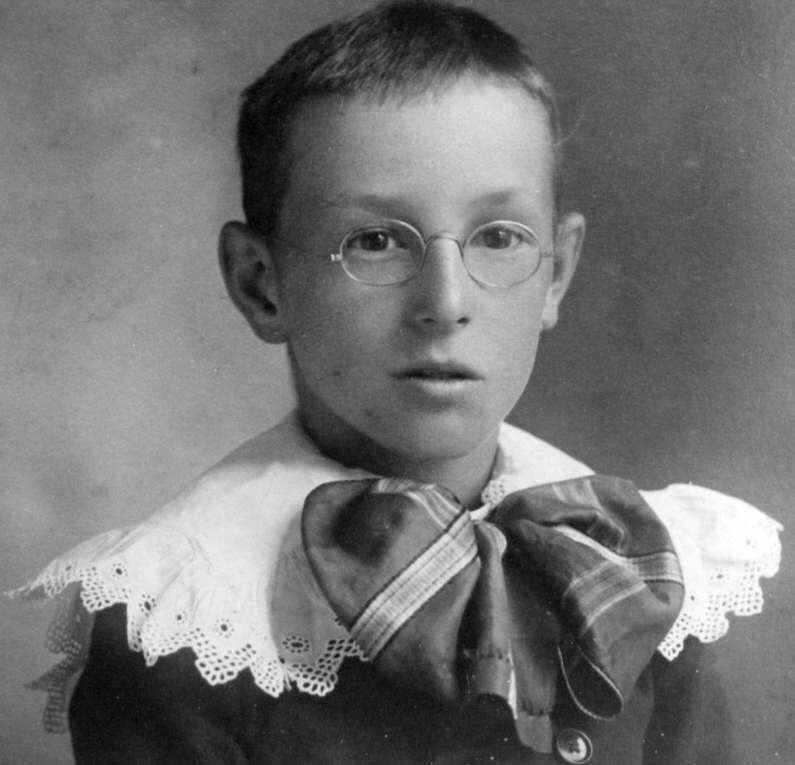
American Boys Eye Glasses: Chronology

Figure 1.--This unidentified boy looks to be about 10 years old. He wears wire-farme glasses, the popular style in the 19th and early-20th century. Note the oblong shape. The portrait was taken about 1900-05. (The clothing could have been seen in the 189s, but the mount suggests it was taken after the turn-of-the 20th century. The studio was Tooke in Westfield, Massachusetts. Note that despite the lace collar, the boy is wearing a regular suit jacket ad not a Fauntleroy jacket.
|
|
America played an important role in the development of glasses in the 18th century when Benjamin Franklin invented bifocals. They were, however, mostly for older people. And as far as we know, America played no further role in eye glass technology until the mid-20th century. We note high-quality lens for binoculars, cameras, and telecopes being imported from Europe, often Germany. We are not sure about the eyeglass industry in the 19th century. We think glasses were mostly produced domesically, but we are not et sure about this. We see American children wearing mostly wire-frame eye glasses in the 19th century. We do not see many boys wearing glassess for portraits in the 19th century. Perhaps they removed their glasses for the portrait. But we think that glassess were probably not as common for children as is the case today. Many children, especially younger children, with vission problems probably went undiagnosed. This was especially the case in the early- and mid-19h century when many children did not attend school. That said, relative affluence and a strong public education system may have meant that more American children that needed glasses got them than was the case in much of Europe. We contiue to see mostly wire-frame glasses in the early 20th century. Only after World war II do we beggin to see more varied styles. The military used plastic frames during World War II. We begin to see plastic frames for children after the War in a wide range of styles.
The 18th Century
America played an important role in the development of glasses in the 18th century when Benjamin Franklin invented bifocals. They were, however, mostly for older people. And as far as we know, America played no further role in eye glass technology until the mid-20th century. The only eyeglasses we note are wire frames, but we know that hornrims were worn to a lesser extent.
The 19th Century
We note high-quality lens for binoculars, cameras, and telecopes being imported from Europe, often Germany. We are not sure about the eyeglass industry in the 19th century. We think glasses were mostly produced domesically, but we are not et sure about this. We see American children wearing mostly wire-frame eye glasses in the 19th century. We do not see many boys wearing glassess for portraits in the 19th century. Perhaps they removed their glasses for the portrait. But we think that glassess were probably not as common for children as is the case today. Many children, especially younger children, with vission problems probably went undiagnosed. This was especially the case in the early- and mid-19h century when many children did not attend school. That said, relative affluence and a strong public education system may have meant that more American children that needed glasses got them than was the case in much of Europe.
The 20th Century
We contiue to see mostly wire-frame glasses in the early 20th century. Only after World war II do we beggin to see more varied styles. The military used plastic frames during World War II. We begin to see plastic frames for children after the War in a wide range of styles. Plqstic is a maleable material that can easily be made into different shapes. It could also be colored. These characteristics provided ebndless possibilities for stylists.
The 21st Century
HBC

Navigate the Boys' Historical Clothing Web Site:
[Return to the Main U.S. eye glass page]
[Return to the Main eye glass country page]
[Return to the Main eye glass page]
[Return to the Main U.S. garment page]
[Introduction]
[Activities]
[Advertisements]
[Biographies]
[Chronology]
[Clothing styles]
[Countries]
[Topics]
[Bibliographies]
[Contributions]
[FAQs]
[Glossaries]
[Images]
[Registration]
[Tools]
[Boys' Clothing Home]
Created: 5:45 AM 1/15/2009
Last updated: 12:05 AM 1/30/2009



